Books
Books

Snaturamenti
A workbook by Flatform on displacement, conceived and curated by Giuliana Prucca.
The book is published under four different covers and with four different layouts, randomly distributed.
Founded in 2006 and based in Berlin and Milan, Flatform is a video and media arts collective, at the border between experimental cinema and contemporary art, that creates time-based works, film events, and installations, most of which revolve around landscape and biopolitics. Distributed by Light Cone in Paris and by Video Data Bank in Chicago, works by Flatform have competed in major film festivals including Cannes, Rotterdam, Venice, Toronto, and have been shown worldwide in art venues such as Centre Pompidou, Haus der Kulturen der Welt, Hirshhorn Museum, MAXXI Museum, Eye Filmmuseum, Wexner Center for the Arts and Garage Center for the Arts.
Co-published by Light Cone and Avarie.

Notes On Just Back From Los Angeles: A Portrait Of Yvonne Rainer
Adam Pendleton’s Notes on Just Back From Los Angeles: A Portrait of Yvonne Rainer stems from the transcript of the script prepared by Pendleton for Yvonne Rainer to read during their day spent filming at the Ridgeway Diner in Chelsea. The text mixes citations from Stokely Carmichael, Malcom X, Keeanga-Yamahtta Taylor, and excerpts from Rainer’s own published works; the film ends with the gospel song ‘I Am Saved’ by the Silver Harpes over the footage of Rainer’s now canonical Trio A, 1978. Pendleton's chapbook plays on the duality of meaning in the word ‘movement’, exploring the synchrony of art and politics, and shared potentials of language and the non-verbal.
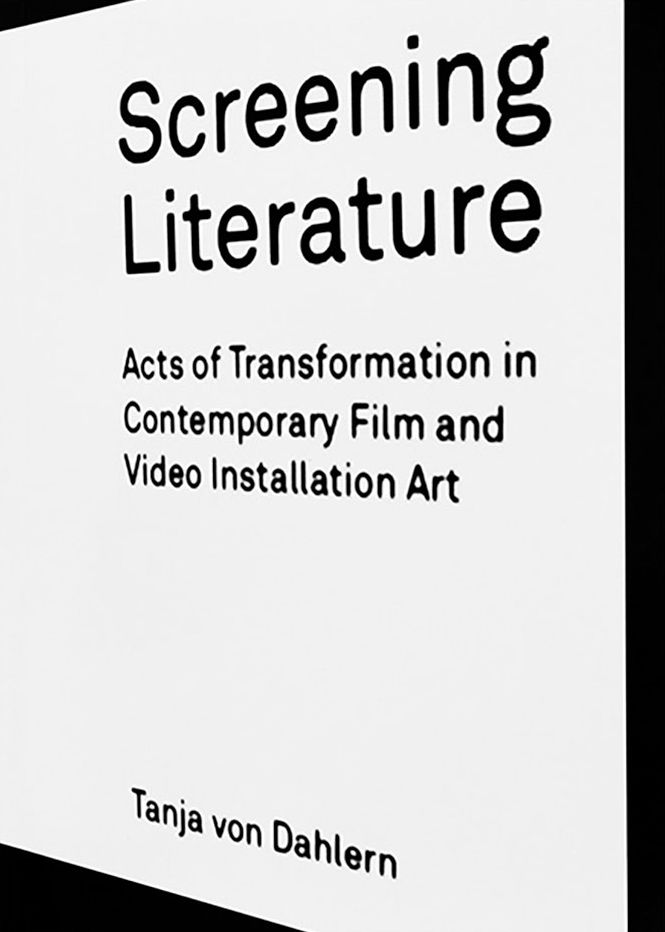
Screening Literature
Based on the doctoral thesis of Tanja von Dahlern, this book examines the ways in which literary works have been staged and transformed in visual art, specifically in the field of contemporary film and video installation since the mid-1990s.
Focusing on artworks by Kutlug Ataman, Gerard Byrne, Stan Douglas, and Fiona Tan, it explores the role of literature in relation to cultural memory, as a place where narrative conventions are negotiated, and where cultural space is mediated and constructed. Transformation is discussed as an important element in our culture today, drawing on theories from intertextuality, intermediality, adaptation studies, and artistic appropriation.

From static oblivion
A reflection about the status of the image as a balance of forces in tension and a paradoxical act of cancellation of the body through its own representation.
In Ion Grigorescu’s work, as in the book, the body is continually shown in different ways - from photography to film, from performance to drawing - and yet it remains absent, obscuring its own identity in an attempt to question the collective one. As it is impossible to show his art during the regime, it ends up hiding, disappearing inside the image. Instead of showing, the image conceals, because it is non-documentary and non-transmittable; it is an act of birth, a prove of the artist’s resistance, especially as a human being inside (or against) any geographical or historical background. In the rituals of his gestures and in the symbolism of his performances, Grigorescu finds a way to stay alive, preserving his own intellectual status while also defending the dignity of everyday life.
The book traces the progression, both expansive and inclusive, of his work, which inscribes itself into the space of the body and of the world. Grigorescu absorbs elements of the surrounding reality, showing us a continuity between art and life: his act of dissidence is not an outcry of provocation, nor is it extreme; it is an anti-aesthetic operation which uses experimentation and rough techniques to uncover the fiction of art, to denounce the artifice of representation and to affirm images as an instrument of subversive power.
Ion Grigorescu (Bucharest, 1945) is one of the most significant Romanian contemporary artists of the Post-War period and an iconic figure of the conceptual and performative art since the early 70s. He represented Romania at Venice Biennial in 1997 and 2011; his works are in the main public collections, such as MoMA, New York; mumok and Erste Foundation, Vienna; Tate Modern and Deutsche Bank AG, London; Centre Pompidou, Paris.

Ana Mendieta - Search for Origin
G. Gourbe, C. Guardiola Bravo and 2 more
Devoted to Cuban-born American artist Ana Mendieta (1948–1985), this monograph appears with an exhibition at Museo de Arte Contemporáneo de Castilla y León, which brings together around 100 works from over fifteen years of production (1968–1985). The exhibition explores how the artist never ceased to reinvent herself through political and vibrant contemporary work, developing an original, ephemeral sculptural language, at times performative in act and informed by her research into primitive myths and rock art. It reveals her relationship to the visible and invisible, her way of rendering the unspeakable intelligible through traces of the body and its relation to nature.

Citizens of the Cosmos
This book on the films of Anton Vidokle features essays and conversations by theorists, curators, and artists exploring the themes of technological immortality and resurrection informed by Cosmist philosophy.
Citizens of the Cosmos examines the artist Anton Vidokle's films and the Cosmist philosophy underpinning them. It features essays and conversations with Vidokle by seminal contemporary theorists, curators, and artists: Franco "Bifo" Berardi, Keti Chukhrov, Liam Gillick, Boris Groys, Daniel Muzyczuk, Miguel Amado and Georgia Perkins, Elizabeth Povinelli, and Raqs Media Collective. This is the first book to survey Vidokle's Cosmism-related filmic output, begun in 2014, and includes full scripts from the films.
The book's contributors speculate on Vidokle's Cosmist conceptions of technological immortality, utopian resurrection, museology, and space travel, grappling with how these ideas embroil or crystallize contemporary theories, practices, and technologies: atmospheric manipulation, cryonics, biopolitics, extraplanetary prospecting, geo-engineering, transhumanism, genetics.
Franco "Bifo" Berardi disagrees with the Cosmist conjecture of death as a flaw in the conception of the human being. Elizabeth Povinelli digests the life-nonlife mattering of dust through relationships to and from the human and more-than-human ancestors to come.
Boris Groys contemplates the gravitational forces between Cosmism and communism according to cosmic and social orders, grounded as they are in the laws of both physics and socialist politics. Keti Chukhrov considers the formation of thinking through madness, dying, and reasoning according to Cosmist philosophical and religious debates and beliefs.
Raqs Media Collective and Anton Vidokle discuss different cultures of death, finitude, and rituals. Miguel Amado and Georgia Perkins examine the in-betweeness of the categories of life and death through the designs of terraforming vehicles navigating interplanetary space travel.
Daniel Muzyczuk investigates Vidokle's interests in the context of the history of the collection at the Muzeum Sztuki in Łódź, while Liam Gillick and Anton Vidokle converse about filmmaking references and methods, from voiceover narrative to editing processes.
Edited by Miguel Amado. Contributions by Franco "Bifo" Berardi, Keti Chukhrov, Raqs Media Collective, Liam Gillick, Boris Groys, Daniel Muzyczuk, Miguel Amado and Georgia Perkins, Elizabeth A. Povinelli.

Raven Chacon: A Worm’s Eye View From a Bird’s Beak
Stefanie Hessler, Katya García-Antón and 1 more
A career-spanning catalogue featuring excerpts from Raven Chacon’s scores, musical prompts, and drawings interspersed with full-color documentation and descriptive texts of installations, sculptures, and performances. Raven Chacon is a composer and artist creating musical experiences that explore relationships among land, space, and people.
In an experimental practice that cuts across the boundaries of visual art, performance, and music, Chacon breaks open musical traditions and activates spaces of performance where the histories of the lands the United States has encroached upon can be contemplated, questioned, and reimagined. In 2022, Raven Chacon became the first Native American to win the Pulitzer Prize for Music, and was awarded a prestigious MacArthur “genius” fellowship in 2023.
Texts by Raven Chacon, Lou Cornum, Aruna D'Souza, Candice Hopkins, Anthony Huberman, Ingir Bål Nango, Marja Bål Nango, Dylan Robinson & Patrick Nickleson, Eric-Paul Riege, Sigbjørn Skåden, Ánde Somby.
Foreword by Katya García-Antón and Stefanie Hessler.

Vital Signs: Writings on Gesture
Vital Signs brings together writings by artist Melissa Gordon, which she has performed live over the past decade in various contexts.
Focusing on the role and behaviour of gesture in her painting practice and that of others, Gordon’s texts move between topics of dropping out, (female) genius, con jobs, how one ‘speaks’ in painting, and notions of ‘suckcess’. Gordons’ writing emerges from a history of feminist organising and editing. Vital Signs shows the development from editor to writer to stand-up performer, and the shuffling and re-combination of the texts with each performative iteration.
The selected pieces – most published here forthe first time – are accompanied by full-page details of Gordon’s body of paintings titled Female Readymades, where inventories of objects, texts, letters, and gestures hang on fences and walls inside larger architectural installations.

Radical Film, Art and Digital Media for Societies in Turmoil
Ursula Böckler, Julia Lazarus and 1 more
Can radical film practices help to understand a disintegrating world? Can they have a healing effect? How can we maintain structures of solidarity in the field of radical media production for societies in turmoil and transition? And what does radical cultural practice look like in times such as ours, when everywhere we turn there seem to lurk even more acute challenges?
Edited by members of the Berlin chapter of the International Radical Film Network, this collection investigates practices of audio-visual production that act on and struggle with the conditions of our time. The contributions were created by film practitioners, artists, activists, as well as academics and critics.

Hell’s Gates II Retribution
Melbourne designer and publisher Tim Coghlan has built his output around the results of both wayward and strategic Google Images searches. Amidst the morass of images that drown the digital present – not to mention the cloud of desensitisation that rises in its wake – some photographs still hold the acute charge and resonance they always did.
Filled with lo-res, amateur, and public domain photographs of burning churches found online, including screen captures from TV news broadcasts, this second volume of Coghlan’s investigative project continues to pose questions of iconography, typology, and the implications of images.
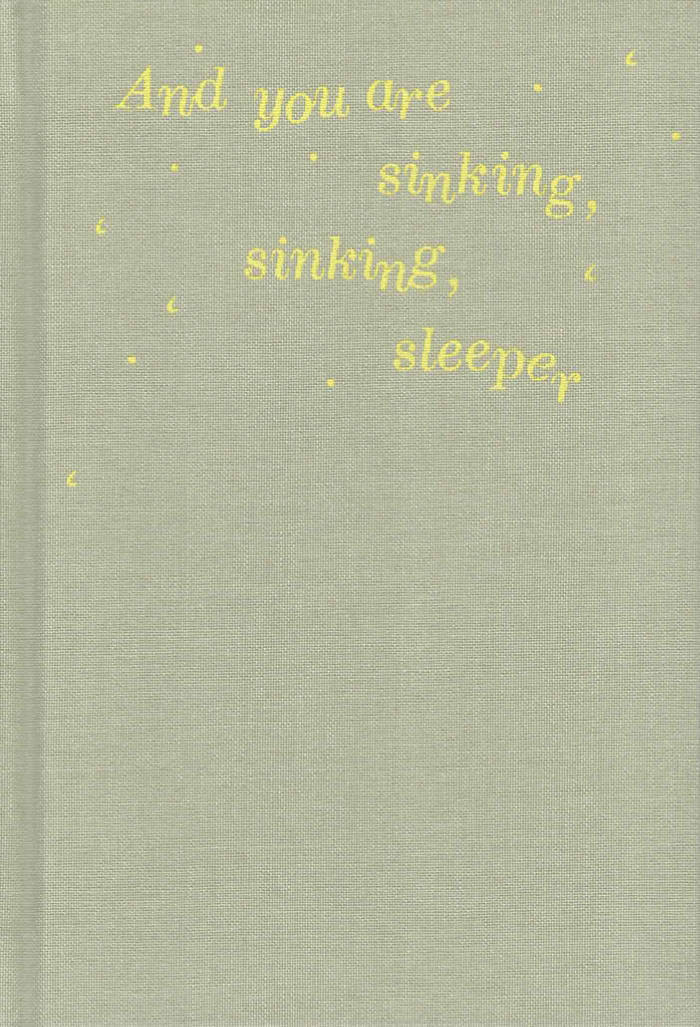
And you are sinking, sinking, sleeper
The topics in this publication circle around watery submerged knowledge; including the drowned land between the Netherlands and Britain (called Doggerland), the Neolithic marine goddess, Nehalennia, and the timber ritual circle referred to as Seahenge.
‘And you are sinking, sinking, sleeper’ focuses on how the ancient peoples of the Netherlands related to the ocean and surrounding waters. The publication consists of resources and notes the author took in her journal during the research process, a series of prints she made while in residence Frans Masereel Centrum and a fictionalized reflection on her own personal relationship to water while living in such a wet wet land.

Our Silver Lining
Our Silver Lining is an ongoing collection of everyday observations by Maite Vanhellemont.
"All film stills and photos collected in this publication were unstaged and shot between the spring of 2018 and the winter of 2020 using a iPhone 8. A selection of the film stills was previously shown during a digital pop-up exhibition in Amsterdam's subway network in the context of Museum Nacht 2019.
The text ‘Wat Niemand Ziet’ is also part of Jan Zwaaneveld’s collection of short stories of the same name, which was published in the spring of 2021. The title of this publication refers to a text I came across above a house in Ostend (BE), during a family weekend in the autumn of 2018. Perhaps according to some a cliché, but I experienced this as a piece of poetry, which you sometimes just stumble upon."

Russian Colonialism 101
For years, Ukrainian journalist Maksym Eristavi has been mainstreaming the global awareness about the legacy of Russian colonialism. A few days before Russia launched a full-scale invasion of Ukraine, he started a Twitter thread listing all Russian colonial invasions over the last century and highlighting one specific pattern that they all went by. The post has gone viral and is now dubbed the "mother of all Russian colonialism tweets". Together with a group of Ukrainian artists, Eristavi transformed it into an illustrated pocket guide to the 48 most recent invasions of Russian colonialism — to bring everyone’s attention to a pattern of serial behavior by the largest colonial empire.
Publication is prepared with the support of the MOCA NGO and the Ukrainian Emergency Art Fund in collaboration with the Sigrid Rausing Trust. Some illustrations created during the illustrative workshop for the book Russian Colonialism 101 have been donated to the Ukrainian Museum of Contemporary Art (UMCA).

this simulation sux
Jr Ting Ding, DeForrest Brown Jr.
this simulation sux is a collection of speculative essays and personal observations commissioned by global cultural institutions and local counterculture zines between February 2020 and April 2021.
"During the moment of pause brought on by the initial lockdown, we chose to write as a form of self care and mediated therapy; writing, for us, is a way to process, orient, and grasp for a moment of clarity in the ever changing media and cultural landscape. In this informational era, in which our attention is in very high demand, the amount of content we are expected to consume is endless. Beset with political unrest, economic uncertainty, and waning emotional bandwidth, we have become datapoints in the vast and saturated marketplace presented to us as “society.”
[...]
Flânerie, the French term describing the act of walking and observing, became a part of our daily ritual; we lapped the outer edges of the island of Manhattan and exploring various neighborhoods during the peak of the pandemic. The images presented on this book’s jacket were captured on these walks, documenting the absurdities of everyday life in this fraying simulation. Personal, anecdotal narratives of an imagined reality are represented through the images, which are placed alongside our speculative observations derived from historical data.
We hope that these writings can provide others with prose and information that can be applied like an antidotal balm to treat our communal ailment of future shock."
—Ting Ding 丁汀 & DeForrest Brown, Jr.

Manifesto Of The Communist Party
In the tradition of Suhrkamp Verlag and Penguin Classics, Domain offers a series of elegantly designed pocketbooks, conceived as a starter kit for radical liberatory thought. The pocketbooks are individually crafted with custom book jackets tailored to each individual buyer; every purchase receipt supplying the raw material for each design. The online fulfillment system leverages the graphic language of the US Postal Service for each cover and packaging design.
The Communist Manifesto (German: Das Kommunistische Manifest), originally the Manifesto of the Communist Party (Manifest der Kommunistischen Partei), is a political pamphlet written by Karl Marx and Friedrich Engels, commissioned by the Communist League and originally published in London in 1848. The text is the first and most systematic attempt by Marx and Engels to codify for wide consumption the historical materialist idea that "the history of all hitherto existing society is the history of class struggles", in which social classes are defined by the relationship of people to the means of production. Published amid the Revolutions of 1848 in Europe, the Manifesto remains one of the world's most influential political documents. (From Wikipedia)
More on https://d-o-m-a-i-n.org/Pocketboks

Fraitaxtsēs sores tsîn ge ra≠gâ – Ondjembo yo Null Vier
A complete documentation on a multimedia exhibition by Berlin-based artist Ixmucané Aguila, giving voice to voiceless descendants of victims of genocide in Namibia.
Genocide in Namibia is an especially sensitive matter—its history has at times been ignored, underestimated, or even denied outright. In the artistic documentary Fraitaxtsēs sores tsîn ge ra≠gâ – Ondjembo yo Null Vier, Ixmucané Aguilar has worked in close collaboration with Nama and OvaHerero people who vividly evoke memories and rituals of mourning caused by human loss and land dispossession under Imperial Germany's violent occupation.
From these personal encounters emerge portraits, visuals and narratives as documental fragments, consisting of living voices which insist on defending memory as an invocation to witness and never to remain passive in the face of social injustice. Rather than a linear collection of data referring to distant places and its distant past, this work engages with stories as chronicles calling to be recognised as pieces of humanity and time.
Alongside Aguilar's portraits, this publication also contains contributions by human rights attorney Wolfgang Kaleck and the curator of the work Tristan Pranyko, along with poetry by Namibian artists Nesindano Namises, Fritz Isak Dirkse and Prince Kamaazegi, and narratives, testimonies, chants and mourning rituals shared by OvaHerero and Nama people in present-day Namiba.
Published on the occasion of the eponymous exhibition at National Art Gallery of Namibia, Windhoek, in 2023
Ixmucané Aguilar (born 1983) is a Guatemalan Berlin-based visual artist/designer who, through multi-layered documentary photography, engages in extensive field research to put out installations and art publications to relay her work in an artistic language.
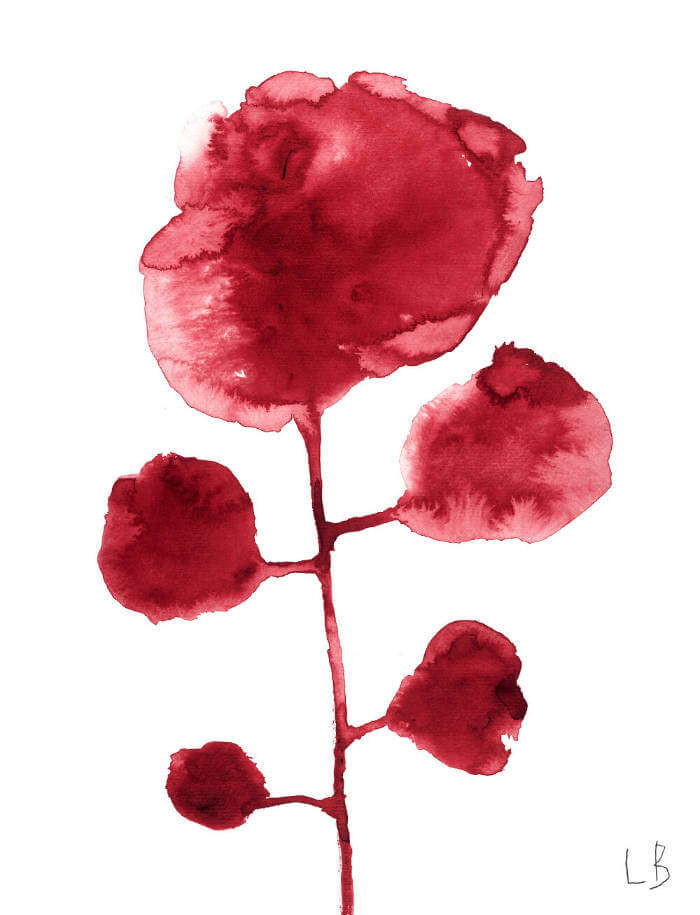
Les Fleurs
Louise Bourgeois' flowers series, painted in gouache on paper.
Born in Paris in 1911 and a New Yorker since 1938, Louise Bourgeois created a unique oeuvre—that owes no allegiance to 20th-century "isms"—in the course of a career than has spanned more than 60 years. Psychologically charged and dealing with the realm of human emotion (love, desire, dependency, sexuality, rejection, jealousy, and abandonment), her art is grounded in her own life and experience: "My goal is to re-experience a past emotion … to relive anxiety … anxiety is a passive state, and the object is to be active and take control." Yet Louise Bourgeois did not create an autonomous universe as an artistic hermit. While her art is nourished by personal experience, it also draws from art and art history—a wellspring of inspiration from which she developed her themes, concepts, and approach to media in both two- and three-dimensional works.
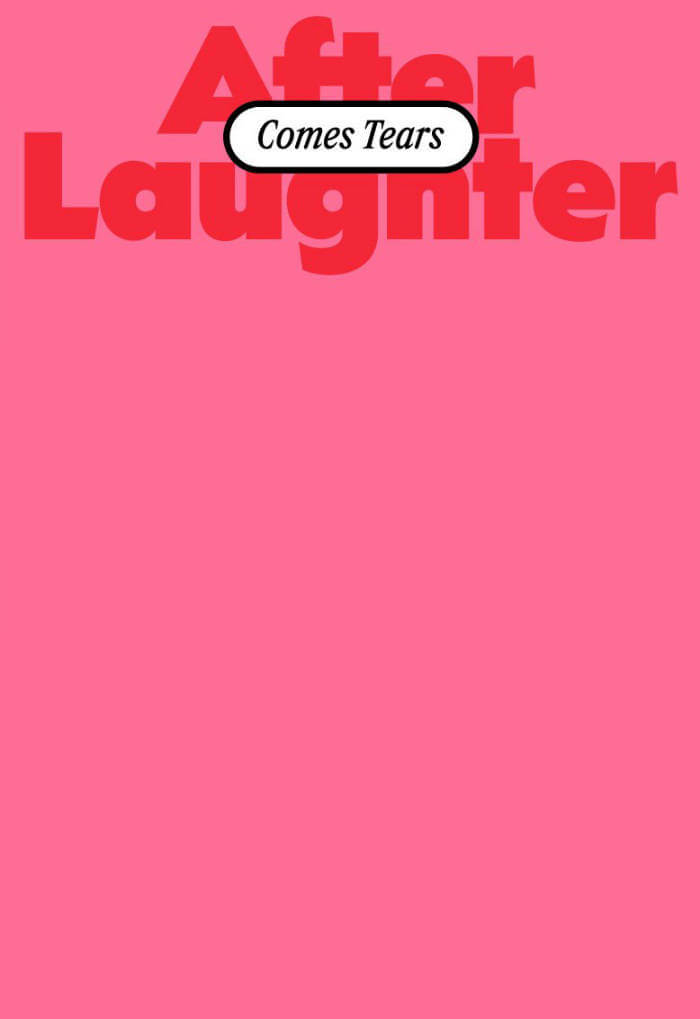
After Laughter Comes Tears
Joel Valabrega, Clementine Proby and 1 more
After Laughter Comes Tears, in its exhibition and book forms, brings together artists from different generations who are experimenting with the idea of the performative. This publication follows the structure of the exhibition at Mudam Luxembourg, with a prologue, four acts and an epilogue, which each sample excerpts from the range of theory, fiction and poetry that inspired and substantiate the themes of the exhibition. Widening the spectrum of the traditional catalogue, each artist was given a "carte blanche"—an invitation to contribute to the book on their own terms.
This performative book was conceived as a story; a story of the pains, joys, anxieties and doubts of the 2020s. It takes as a starting point, the feelings of stasis and anger that define the present stage of late capitalism, framed by the anxieties of a generation facing a climate crisis, welfare states trampled and failed by neoliberal policies and the rise of xenophobia around the globe, partly fueled by fake news spreading on- and offline. It is an intuitive journey through the voices of thirty-four artists expressing the lurid shapes of the crises that surround us and form a (never exhaustive) part of our contemporary reality.
They are Cem A., Panteha Abareshi, Monira Al Qadiri, Kate Cooper, Pauline Curnier Jardin, Jesse Darling, Stine Deja, Omer Fast, Anna Franceschini, Guan Xiao, Sidsel Meineche Hansen, Lukáš Hofmann, Christian Jankowski, Chris Korda, Ndayé Kouagou, Ghislaine Leung, Isaac Lythgoe, Taus Makhacheva, Diego Marcon, Jacopo Miliani, Marie Munk, Chalisée Naamani, Agnieszka Polska, PRICE, Jean-Charles de Quillacq, Mika Rottenberg, Julika Rudelius, Dorian Sari, Sin Wai Kin, Shinuk Suh, Martine Syms, Mungo Thomson, Cajsa von Zeipel, and Artur Żmijewski.
Edited by Clarisse Fahrtmann, Clementine Proby, Joel Valabrega.
Foreword by Bettina Steinbrügge.
Contributions by Kate Cooper, Lukas Hofmann, David McDermott, Markus Pilgram, Agnieszka Polska, Clémentine Proby, Sin Wai Kin, Bettina Steinbrügge, Geraldine Tedder, Joel Valabrega, Lauren Wetmore.

Material Marion von Osten 1 – MoneyNations
The first volume in a series devoted to Marion von Osten's archives, around the MoneyNations project, transversing between art, theory, and activism.
MoneyNations was an exhibition, a webzine, a radio, a conference, a video archive, a printed publication, an infrastructure, a counterpublic, an ongoing discussion, a transnational network of friends. Initiated by Marion von Osten as curator at the Shedhalle Zurich, the project evolved from an urgency to act against the hegemonic forces of "the West" within the radically changing condition of post-Cold War Europe. MoneyNations addressed—and intervened in—the interrelatedness between racist border policies and media representations, exploitative economic relations, and identity-forming processes. The applied methods of critique and organizing, transversing between art, theory, and activism, are made accessible in this volume through images, correspondences, and other ephemera, revealing their political potential for the present. It is contextualized by a conversation between Sezgin Boynik (Rab-Rab Press), Ferdiansyah Thajib (KUNCI Study Forum & Collective), Eleanor Ivory Weber, Camila Willis (Divided Press) and the editors.
The Material Marion von Osten series periodically publishes selected archival documents from von Osten's projects and contextualizes them with new contributions. Correspondences, drafts, scripts, photographs, videos and printed matter serve as the starting point for the publication series which maps the complexity of Marion von Osten's transversal cultural production in its details and specifics.
The artist, curator, researcher, and educator Marion von Osten (1963-2020) lived in Berlin since the early 1990s. Her always collaborative approach manifested in exhibitions, conferences, installations, as well as films, discussions, texts, teachings, or self-published journals. Her projects were all intertwined and carried by her specific way of working: through artistic research and feminist organizing, transnational and committed to the project of decolonization. Amongst her works are the international exhibition series bauhaus imaginista (2018-2020), Viet Nam Discourse (2016-2018) at Tensta Konsthall, Project Migration (2002-2006) in Cologne, and Sex & Space (1996) at Shedhalle Zurich. As collective infrastructures, her collaborations included Labor k3000, kleines postfordistisches Drama (Minor Postfordist Drama, kpD) and the CPKC Center for Postcolonial Knowledge and Culture.
Edited by Lucie Kolb, Jonas von Lenthe, Max Stocklosa.
Conversation between Sezgin Boynik, Ferdiansyah Thajib, Eleanor Ivory Weber, Camila Willis and the editors.
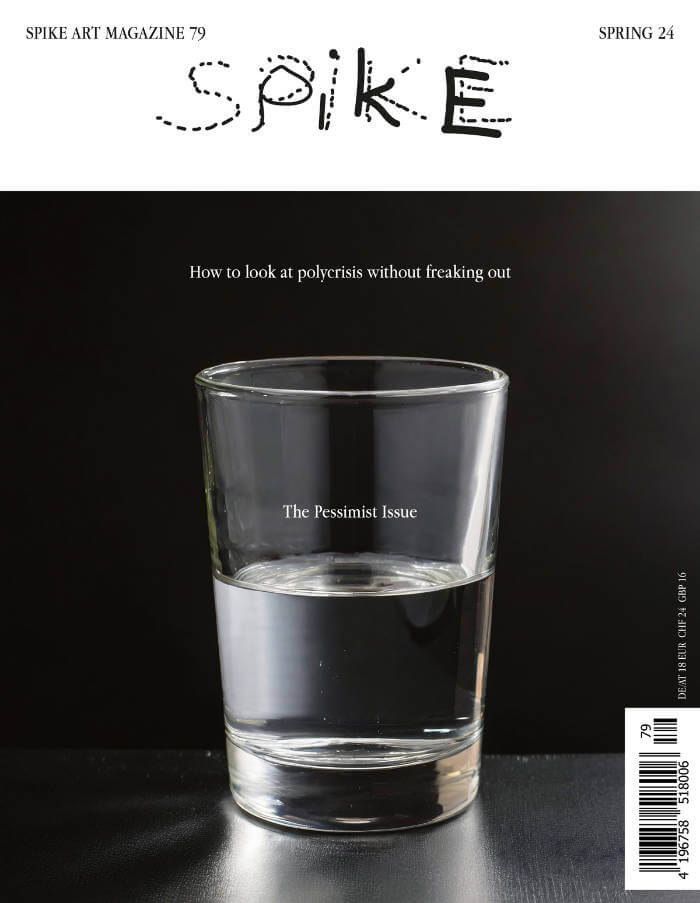
Spike #79 – The Pessimist Issue
How to look at polycrisis without freaking out.
Eco ruin and refugeeism, illiberalization and inequality, hot wars and a New Cold War—the polycrisis hydra is always growing another head. But it's also a state of mind, an identity crisis brought on by paralysis and cognitive shock. Was it always like this, but with less media reach? Or is capitalism really burning itself out, just without any redemptive zest? The arts are expert at thematizing the woes that affect them—hello, Biennale and documenta—but maybe polycrisis is an instructive metaphor for what's breaking creativity: the commercial takeover of discourse, the bureaucratization of curating, and the dopamine highs of self-branding.
Maybe we're at a crossroads between recovery and death. But Spike #79 is clear-eyed about the fact that pessimists are never disappointed.
With Henrike Naumann, Shirin Neshat, Roberto Villanueva, Ben Davis, Mire Lee, Precious Okoyomon, Ivan Cheng, Nil Yalter, Anselm Franke, Anna Jermolaewa, Catherine Liu, Oliver Ressler, Morag Keil, Jeppe Ugelvig and many more.
Founded by the artist Rita Vitorelli in 2004, Spike (Spike Art Quarterly) is a quarterly magazine on contemporary art published in English which aims at sustaining a vigorous, independent, and meaningful art criticism. At the heart of each issue are feature essays by leading critics and curators on artists making work that plays a significant role in current debates. Situated between art theory and practice and ranging far beyond its editorial base in Vienna and Berlin, Spike is both rigorously academic and stylishly essayistic. Spike's renowned pool of contributing writers, artists, collectors and gallerists observe and reflect on contemporary art and analyse international developments in contemporary culture, offering its readers both intimacy and immediacy through an unusually open editorial approach that is not afraid of controversy and provocation.

Otherwise Worlds
Andrea Smith, Jenell Navarro and 1 more
The contributors to Otherwise Worlds investigate the complex relationships between settler colonialism and anti-Blackness to explore the political possibilities that emerge from such inquiries. Pointing out that presumptions of solidarity, antagonism, or incommensurability between Black and Native communities are insufficient to understand the relationships between the groups, the volume's scholars, artists, and activists look to articulate new modes of living and organizing in the service of creating new futures. Among other topics, they examine the ontological status of Blackness and Indigeneity, possible forms of relationality between Black and Native communities, perspectives on Black and Indigenous sociality, and freeing the flesh from the constraints of violence and settler colonialism.
Throughout the volume's essays, art, and interviews, the contributors carefully attend to alternative kinds of relationships between Black and Native communities that can lead toward liberation. In so doing, they critically point to the importance of Black and Indigenous conversations for formulating otherwise worlds.
Contributors. Maile Arvin, Marcus Briggs-Cloud, J. Kameron Carter, Ashon Crawley, Denise Ferreira da Silva, Chris Finley, Hotvlkuce Harjo, Sandra Harvey, Chad B. Infante, Tiffany Lethabo King, Jenell Navarro, Lindsay Nixon, Kimberly Robertson, Jared Sexton, Andrea Smith, Cedric Sunray, Se’mana Thompson, Frank B. Wilderson
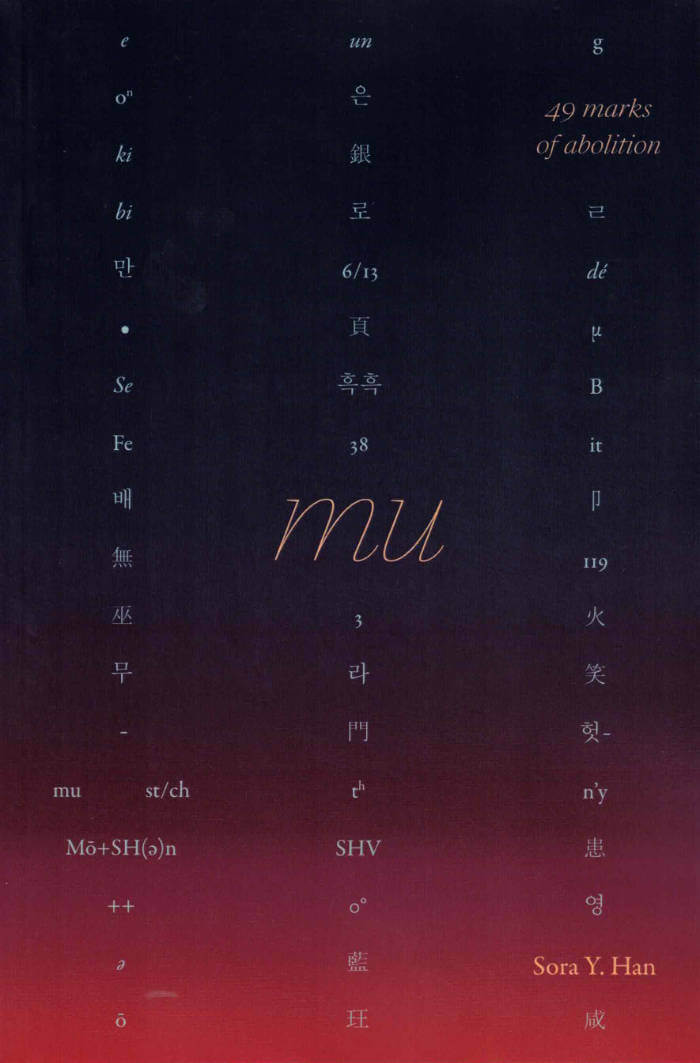
Mu, 49 Marks of Abolition
In March 2020, Sora Y. Han learned her father was dying of cancer just as the COVID-19 pandemic arrived on California's shores. These two events led Han to introspection: “Who have I been writing to?” and “Who have I been writing for?” In her observance of the 49 days of mourning in Buddhist tradition, answers come in the form of mu – no thing, nothingness.
Han’s poetic meditations on freedom struggle come alive in the empty spaces between words, letters, and pictograms spanning her many languages—English, Korean, Chinese, jazz, law, and poetry.
Transliterating and dystranslating the writings of Fred Moten, Theresa Hak Kyung Cha, Jacques Lacan, Frantz Fanon, and others through the Korean alphabet, Han weaves the DMZ, Betty’s Case, the Thirteenth Amendment, Afro-pessimism, and psychoanalytic desire together into the open field of Bay Area radicalism. Mu is both a loving homage to and a playful subversion of political inheritances and the unsayable beyond law.
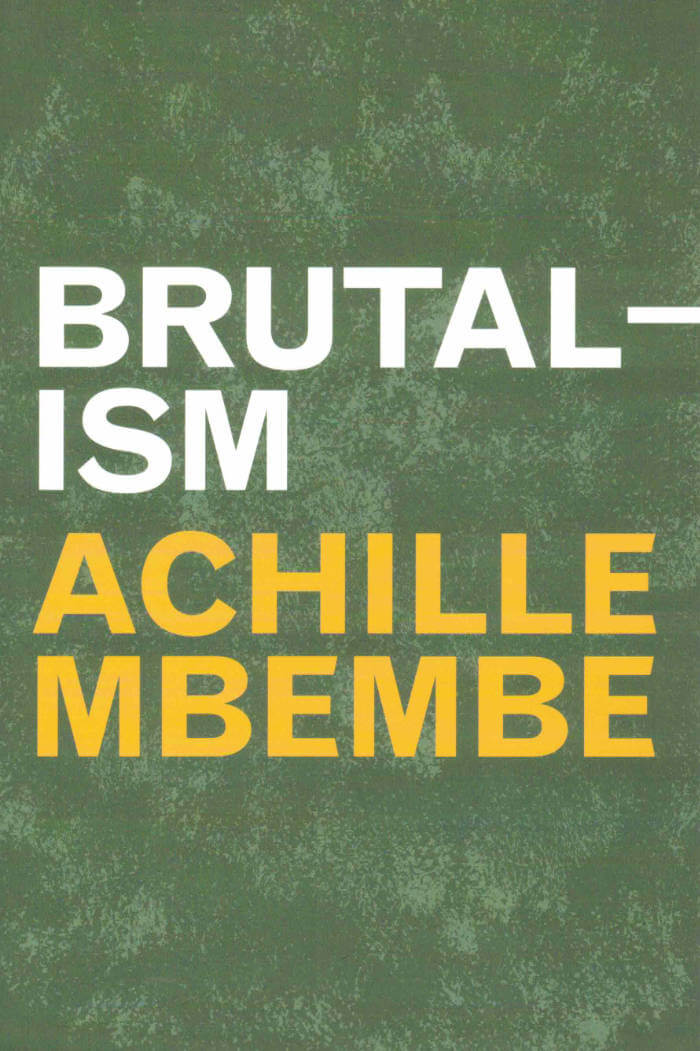
Brutalism
In Brutalism, eminent social and critical theorist Achille Mbembe invokes the architectural aesthetic of brutalism to describe our moment, caught up in the pathos of demolition and production on a planetary scale.
Just as brutalist architecture creates an affect of overwhelming weight and destruction, Mbembe contends that contemporary capitalism crushes and dominates all spheres of existence. In our digital, technologically focused era, capitalism has produced a becoming-artificial of humanity and the becoming-human of machines. This blurring of the natural and artificial presents a planetary existential threat in which contemporary society’s goal is to precipitate the mutation of the human species into a condition that is at once plastic and synthetic.
Mbembe argues that Afro-diasporic thought presents the only solution for breaking the totalizing logic of contemporary capitalism: repairing that which is broken, developing a new planetary consciousness, and reforming a community of humans in solidarity with all living things.
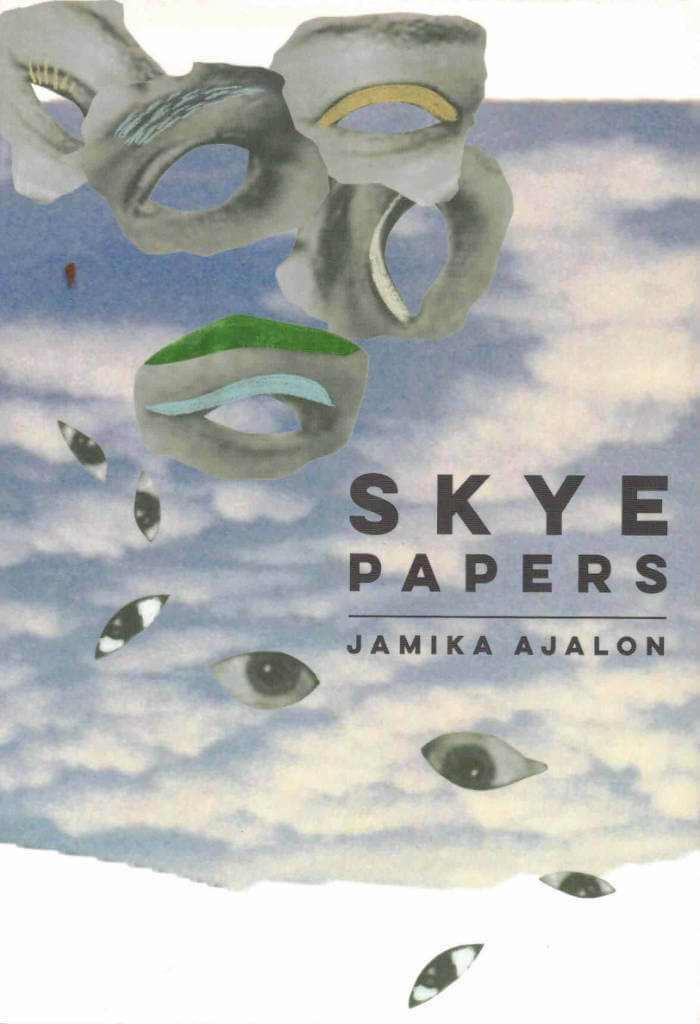
Skye Papers
A dreamy and experimental portrait of young Black artists in the 1990s London underground scene, whose existence is threatened by the rise of state surveillance.
Twentysomething and restless, Skye flits between cities and stagnant relationships until she meets Scottie, a disarming and disheveled British traveler, and Pieces, an enigmatic artist living in New York. The three recognize each other as kindred spirits—Black, punk, whimsical, revolutionary—and fall in together, leading Skye on an unlikely adventure across the Atlantic. They live a glorious, subterranean existence in 1990s London: making multimedia art, throwing drug-fueled parties, and eking out a living by busking in Tube stations, until their existence is jeopardized by the rise of CCTV and policing.
In fluid and unrelenting prose, Jamika Ajalon's debut novel explores youth, poetry, and what it means to come terms with queerness. Skye Papers is an imaginative, episodic group portrait of a transatlantic art scene spearheaded by people of color—and of the fraught, dystopian reality of increasing state surveillance.